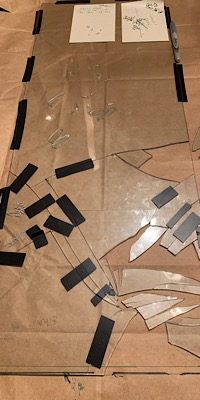Page 1 of 1
Fusing antique glass
Posted: Sat Jul 13, 2019 4:31 pm
by FusedLightStudio
An acquaintance has an antique cabinet from England that has broken gravity glass in one of the two panels. He wants to know if we can fuse the broken pieces together. The break was fairly clean but there are a lot of pieces:

- 239ED37E-FD35-42E4-8D5E-BC5110427AB0.jpeg (33.35 KiB) Viewed 14693 times
I haven’t seen the glass in person yet, but before he drags it over to the studio I wanted to ask if anyone here has attempted such a thing.
We don’t know what decade or where in England it was manufactured. He knows it will not look great fused but strongly wants to keep the antique glass.
Thoughts?
Re: Fusing antique glass
Posted: Sat Jul 13, 2019 10:56 pm
by Kevin Midgley
1. Buy new old glass is the answer.
Make something with the old broken glass as a memento.
2. Obtain a flux that will assist in the melting of the glass. Apply it to the broken edges and assemble and fire.
Problem will be the inevitable missing bits and the change in sizing and shape caused by the heating of the glass.
3. Use UV glue to glue it back together.
Hand the bottle of glue to the owner of the panel so he/she can do it themselves.
4. Make no promises of any sort of success as you have already answered the best answer with number 1.
Re: Fusing antique glass
Posted: Sun Jul 14, 2019 8:45 am
by FusedLightStudio
Thank you Kevin. Your list seems to cover all the bases.
I don’t know what I would use for flux - would appreciate ideas on that. Have never worked with antique glass so I don’t even know how to research such a thing.
Or what the fusing temperature might be.
I’ve only played around with Bondix UV glue. In my tests it didn’t seem that strong and it yellowed pretty quickly. Maybe that’s a separate thread but I’d like to know other people’s favorite UV glue.
Re: Fusing antique glass
Posted: Sun Jul 14, 2019 9:20 am
by Kevin Midgley
Forget anything but number 1.
Seek out new old glass.
Re: Fusing antique glass
Posted: Sun Jul 14, 2019 12:42 pm
by jim simmons
What Kevin said.
The other Jim

Re: Fusing antique glass
Posted: Mon Jul 15, 2019 9:32 am
by Brad Walker
What Jim and Kevin said.
Can't really be done and even if you could figure out how to do it it would cost more than buying new old glass.
Re: Fusing antique glass
Posted: Mon Jul 15, 2019 11:32 am
by AndyT
Agree with #1. you can buy Restoration" glass that looks like the old glass.
Re: Fusing antique glass
Posted: Tue Jul 16, 2019 7:57 am
by FusedLightStudio
Thanks so much for the firm replies, everyone. You’ve saved me a lot of time and frustration.
Re: Fusing antique glass
Posted: Tue Jul 16, 2019 1:56 pm
by DonMcClennen
Just for your future knowledge... If you tried to fuse single thickness glass by butting edges together... they will actually pull away form each other at fusing temps... leaving gaps (holes) in the final piece.
Re: Fusing antique glass
Posted: Wed Jul 17, 2019 8:18 am
by FusedLightStudio
DonMcClennen wrote:Just for your future knowledge... If you tried to fuse single thickness glass by butting edges together... they will actually pull away form each other at fusing temps... leaving gaps (holes) in the final piece.
Thanks. I was wondering about that! Kevin suggested using some kind of flux to make them fuse, but I couldn’t imagine what I would use.
Re: Fusing antique glass
Posted: Wed Jul 17, 2019 9:25 am
by Kevin Midgley
Low firing temperature clear enamel.
If it hits the plaster mold you'd have to make it will make a mess.
If it runs through you'd have a blob on the back side.
A glue that appears to work for glass with unknown longevity is Lepages 100% glue.
The project being discussed, just buy new old glass.
Re: Fusing antique glass
Posted: Thu Jul 18, 2019 7:53 am
by FusedLightStudio
I’m going to start a new thread about GLUES.

Re: Fusing antique glass
Posted: Wed Jul 24, 2019 9:24 pm
by Buttercup
I see you've already been given good advice re buying some new 'old-style' glass. I couldn't find information on gravity glass and haven't heard the term before, but did read quite a bit about Guinness glasses in the search. Being a fan I found that interesting.
Some time ago I put a piece of 2 mil float in the kiln and overheating it trying to replicate old glass as found in picture frames with old prints etc. It did a pretty good job of distorting reflections as old glass often does. I can't find what 'gravity glass' looks like so can't make any other suggestions.
Hope you can resolve the issue for your client satisfactorily.